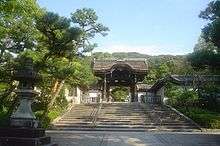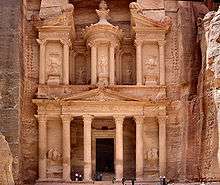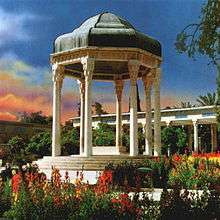Mausoleum
A mausoleum is an external free-standing building constructed as a monument enclosing the interment space or burial chamber of a deceased person or people. A monument without the interment is a cenotaph. A mausoleum may be considered a type of tomb, or the tomb may be considered to be within the mausoleum.
.jpeg)
Overview
The word mausoleum derives from the Mausoleum at Halicarnassus (near modern-day Bodrum in Turkey), the grave of King Mausolus, the Persian satrap of Caria, whose large tomb was one of the Seven Wonders of the Ancient World.[1]
Historically, mausolea were, and still may be, large and impressive constructions for a deceased leader or other person of importance. However, smaller mausolea soon became popular with the gentry and nobility in many countries. In the Roman Empire, these were often in necropoles or along roadsides: the via Appia Antica retains the ruins of many private mausolea for miles outside Rome. When Christianity became dominant, mausolea were out of use.[2]
Later, mausolea became particularly popular in Europe and its colonies during the early modern and modern periods. A single mausoleum may be permanently sealed. A mausoleum encloses a burial chamber either wholly above ground or within a burial vault below the superstructure. This contains the body or bodies, probably within sarcophagi or interment niches. Modern mausolea may also act as columbaria (a type of mausoleum for cremated remains) with additional cinerary urn niches. Mausolea may be located in a cemetery, a churchyard or on private land.
In the United States, the term may be used for a burial vault below a larger facility, such as a church. The Cathedral of Our Lady of the Angels in Los Angeles, California, for example, has 6,000 sepulchral and cinerary urn spaces for interments in the lower level of the building. It is known as the "crypt mausoleum". In Europe, these underground vaults are sometimes called crypts or catacombs.
Notable mausolea

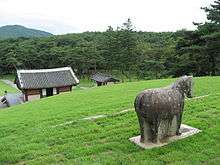
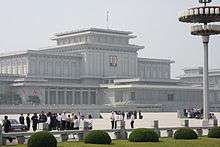
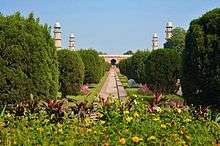
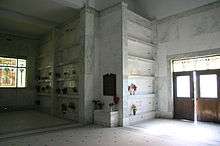
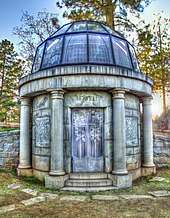
_edit.jpg)
.jpg)
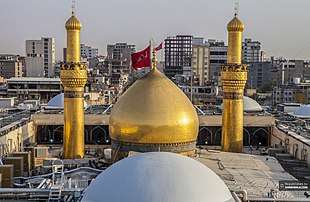
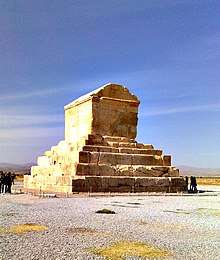

Africa
- Mausoleum of Mohammed V
- Bourguiba mausoleum
- El Alia Cemetery, Mausoleum of the Late President, Algeria.
- The Dr. John Garang De Mabior mausoleum in Juba, South Sudan.
- Mastabas dating from ancient Egypt.
- Agostinho Neto's Mausoleum in Luanda, Angola.
- Mausolée (Pyramide) du Président Mathieu Kerekou, Natitingou, Benin.
- Omar Bongo's Mausoleum (A replica of the Mausoleum of Mohammed V) in Franceville, Gabon.
- Léon M'ba's Memorial Mausoleum in Libreville, Gabon.
- Kwame Nkrumah Mausoleum
- Mausoleum of Late President Levy Mwanawasa, Frederick Chiluba and Michael Sata at Embassy Park in Lusaka, Zambia.
- Domoni Mosque Mausoleum Indoor inside first president of Comoros, Ahmed Abdallah's Mausoleum.
- Marien Ngouabi's mausoleum and Pierre Savorgnan de Brazza's mausoleum in Brazzaville, The Republic of Congo.
- Mausoleum of the late president Felix Houphouet-Boigny in Yamoussoukro, Côte d'Ivoire.
- Laurent Kabila's mausoleum in Kinshasa, The Democratic Republic of Congo.
- The pyramids of ancient Egypt and Nubian pyramids are also types of mausolea.
- Gamal Abdel Nasser Mosque, is the Mausoleum of Gamal Abdel Nasser, in Cairo, Egypt.
- Unknown Soldier Memorial (Egypt)
- Royal Mausoleum of Mauretania
- Al Hussein Mosque, Cairo – Holy Shrine and mausoleum, and purported grave of the Islamic prophet Muhammad's grandson.
- Qalawun Mausoleum is the Mausoleum of Qalawun, Located in Cairo, Egypt, it was regarded by scholars as the second most beautiful medieval mausoleum ever to be built.
- Jedars - thirteen ancient monumental Berber mausoleums located south of Tiaret.
- Palm Grove Cemetery, Monrovia, Liberia.
- National Hall, Mausoleum of the Late President William Tubman in Monrovia, Montserrado, Liberia.
- Late President Eyadema's Family Mausoleum in Kara, Togo.
- Kamuzu Banda Mausoleum, in Lilongwe, Malawi.
- Dr. Bingu wa Mutharika, President of Malawi built a mausoleum in which his late first wife and Bingu himself are buried.
- Meles Zenawi's grave in Holy Trinity Cathedral, Addis Ababa, Ethiopia.
- King Sobhuza II Memorial Park, Lobamba, Swaziland.
- Julius Nyerere's mausoleum in Mwalimu Nyerere Museum Centre, Butiama, Tanzania.
- The Heroes Square, Maputo, Mozambique.
- Amilcar Cabral's mausoleum in Bissau, Guinea-Bissau.
- Mausoleum of the Late President of Kenya Mzee Jomo Kenyatta in Nairobi, Kenya.
- Jaramogi Oginga Odinga Mausoleum, Bondo, Kenya.
- Camayanne Mausoleum and contains the tombs of Guinea national hero Samori Ture, Sekou Toure and Alfa Yaya.
- Nnamdi Azikiwe's Burial Site In Onitsha, Nigeria .
- Abubakar Tafawa Balewa's tomb, Bauchi, Nigeria.
- Mausoleum of Obafemi Awolowo, Ogun State, Nigeria.
- Mausoleum of Sani Abacha, Kano, Nigeria.
- National Heroes Acre in Harare, Zimbabwe.
Asia, Eastern, Southern, and South-East
- Royal Tombs of the Joseon Dynasty, Korea
- Taj Mahal at Agra, India
- Qutb Shahi Tombs at Hyderabad, India
- Gol Gumbaz at Bijapur, India
- Humayun's Tomb at Delhi, India
- Mausoleum of the First Qin Emperor biggest underground mausoleum
- The pyramids of ancient China are also types of mausolea.
- Qianling Mausoleum in China, houses the remains of Emperor Gaozong of Tang and the ruling Empress Wu Zetian, along with 17 others in auxiliary tombs.
- Mausoleum of Genghis Khan in Ordos City, Inner Mongolia.
- Thirteen Imperial Mausoleums of Ming Dynasty Emperors, Beijing
- Ming Xiaoling Mausoleum, Nanjing
- Fuling Tomb, Shenyang
- Zhao Mausoleum (Qing Dynasty)
- Eastern Qing Tombs
- Western Qing Tombs
- Tomb of Jahangir at Shahdara, near Lahore, Pakistan.
- Mazar-e-Quaid at Karachi, Pakistan
- Data Durbar at Lahore, Pakistan
- Mausoleum of Father of the Nation Bangabandhu Sheikh Mujibur Rahman in Gopalganj, Dhaka, Bangladesh.
- Bandaranaike family Estate in Horagolla Bandaranaike Samadhi, Sri Lanka
- Ho Chi Minh Mausoleum, Hanoi
- Kumsusan Palace of the Sun or Kim Il-sung Mausoleum, Pyongyang, Democratic People's Republic of Korea (North Korea)
- Mausoleum of Mao Zedong, Beijing.
- Sun Yat-sen Mausoleum, Nanjing.
- National Dr. Sun Yat-sen Memorial Hall, Taipei.
- National Chiang Kai-shek Memorial Hall, Taipei.
- Mausoleum of Late President Lord Chiang Kai-shek, Taoyuan.
- Mausoleum of Late President Chiang Ching-kuo, Taoyuan.
- Astana Giribangun Suharto family complex in traditional Javanese architectural style in Matesih, Karanganyar Regency, Central Java
- Imogiri complex in Imogiri, Central Java is the cemetery for Mataram royals and the Hamengkubuwana Royals of Yogyakarta and Pakubuwono of Surakarta
- Rizal Monument at Rizal Park in Manila, Philippines, houses the remains of Dr. Jose Rizal, national hero of the Philippines.
- Mausoleum of the Veterans of the Revolution, enshrining participants in the 1896 revolution against the Spanish Empire.
- Quezon Memorial, in Quezon City, Philippines, houses the remains of President Manuel Quezon and his consort, Doña Aurora.
- Marcos Museum and Mausoleum in Batac, Ilocos Norte, Philippines, housing the remains of President Ferdinand E. Marcos.
- Nikkō Tōshō-gū at Nikkō, Tochigi Prefecture, Japan. It is part of the "Shrines and Temples of Nikkō", Mausoleum of Tokugawa Ieyasu, Tokugawa shōguns.
- Rinnō-ji at Nikkō, Tochigi Prefecture, Japan. The temple also administers the Taiyū-in Reibyō (大猷院霊廟), which is the mausoleum of Tokugawa Iemitsu, the third Tokugawa shōgun. Together with Nikkō Tōshō-gū and Futarasan Shrine.
- Zuihōden at Sendai, Miyagi Prefecture, Japan is the mausoleum complex of Date Masamune and his heirs, daimyō of the Sendai Domain.
- Sennyū-ji, Kyoto, Japan.
- Musashi Imperial Graveyard, is a mausoleum complex at Hachiōji, Tokyo, Japan.
- Tamaudun, at Shuri, Okinawa, Japan.
- Kandawmin Garden Mausolea, Myanmar.
- Martyrs' Mausoleum, Myanmar.
Asia, western
- Al-Khazneh at Petra, Jordan
- Mausoleum of Maussollos at Halicarnassus
- Mausoleum of Cyrus the Great in Pasargadae, Iran.
- Naqsh-e Rustam at Persepolis Iran, Tombs of Persian Achaemenid kings (522-486 BCE).
- Tomb of Ferdowsi in Mashhad, Iran.
- Tomb of Hafez (Hāfezieh) in Shiraz, Iran
- The Shrine of the Báb and the Shrine of Bahá'u'lláh in Haifa and Acre, Israel, respectively.
- Imam Husayn Mosque, Karbala – according to Shī‘ah belief,[3] the head and body of Husayn ibn Ali, along with all others who fell at the Battle of Karbala are buried here.
- Imam Reza shrine in Mashhad, Iran
- The Mausoleum of Khomeini in Tehran, Iran
- Anıtkabir mausoleum of Atatürk the founder of the Republic of Turkey at Ankara, Turkey
- Mausoleum of Yasser Arafat in Ramallah, West Bank
Europe
- Bismarck Mausoleum outside Friedrichsruh in northern Germany
- Hamilton Mausoleum at Hamilton in Scotland
- House of Karageorgevich Mausoleum, St. George's Church, Oplenac in Topola, Serbia
- Royal Mausoleum and the Duchess of Kent's Mausoleum at Frogmore, England
- Peter and Paul Cathedral in St. Petersburg, Russia
- Cathedral of the Archangel in Moscow, Russia
- Lenin's Mausoleum in Moscow, Russia
- Cathedral of Saint Domnius in Split, Croatia
- Lajos Batthyány's Mausoleum in Budapest, Hungary
- Mausoleum of Augustus in Rome, Italy.
- Pantheon, Rome in Italy
- Mausoleum of Hadrian in Rome, Italy
- Mausoleum of Theodoric in Ravenna, Italy
- Mausoleum of Galla Placidia in Ravenna, Italy
- Mausoleum of Marasesti in Marasesti, Romania
- Pyramid of Tirana in Tirana, Albania
- Batenberg Mausoleum in Sofia, Bulgaria
- Trentham Mausoleum near Stoke-on-Trent, England
- Panthéon, Paris in France
- Les Invalides in France
- Valle de los Caídos, in San Lorenzo del Escorial, Spain
- Imperial Crypt in Austria
- Church of Our Lady of Laeken in Belgium
- Oplenac Mausoleum in Topola, Serbia, the Mausoleum of the Serbian and Yugoslav Royal House of Karađorđević
- National Pantheon / Church of Santa Engrácia in Lisbon, Portugal
- Mausoleum of Njegoš in Lovćen, Montenegro
- Wilhelm II Mausoleum in Doorn
- Juselius Mausoleum in Finland
Latin America

- El Ángel Victory column and mausoleum to the heroes of the Mexican Independence in Mexico City, Mexico.
- Monumento a la Revolución monument commemorating and mausoleum to the heroes of the Mexican Revolution in Mexico City, Mexico.
- Mexico City Metropolitan Cathedral
- Panteon San Fernando, Mexico City, Mexico.
- Jardines Del Humaya, a cemetery with opulent multi-story and air-conditioned mausoleums of Mexican drug cartel members.
- Obelisk of São Paulo mausoleum to the heroes of Constitutionalist Revolution in São Paulo City, São Paulo, Brazil.
- Chico Xavier mausoleum in Uberaba, Minas Gerais, Brazil.
- Cemitério de São João Batista, Rio de Janeiro, Brazil.
- Panteón de los Próceres, Peru.
- Presbitero Maestro mausoleum and museum in Lima, Peru.
- Cathedral Basilica of St. John the Apostle and Evangelist, Lima
- Mausoleo a los Heroes de El Polvorín, at Cementerio Civil de Ponce in Ponce, Puerto Rico
- Buenos Aires Metropolitan Cathedral, mausoleum of General San Martín.
- La Recoleta Cemetery, Buenos Aires, Argentina.
- La Chacarita cemetery, Buenos Aires, Argentina.
- Mausoleum of Néstor Kirchner, Río Gallegos, Santa Cruz, Argentina.
- Santa Ifigenia Cemetery, Santiago de Cuba, Cuba.
- Los Ilustres Cemetery, Salvador.
- Cementerio General, Trujillo, Honduras.
- Guatemala City General Cemetery
- Cementerio General Occidental, Managua, Nicaragua.
- Cathedral Basilica of Our Lady of Peace, La Paz, mausoleum of Andrés de Santa Cruz, Bolivia
- General Cemetery of Santa Cruz, Bolivia.
- Cementerio General de Cochabamba, mausoleum of “general del pueblo” René Barrientos Ortuño, Bolivia.
- Central Cemetery of Bogotá, Colombia.
- San Diego Cemetery, Quito, Ecuador.
- Haiti’s National Cemetery in Port-au-Prince, where François Duvalier, who ruled from 1957 to 1971, is buried.
- Omar Torrijos Mausoleum, Amador, Panama City, Panama.
- Cathedral of La Plata, mausoleum of Dardo Rocha.
- Artigas Mausoleum, mausoleum of José Gervasio Artigas.
- Altar de la Patria of Chile.
- Cementerio General de Santiago, Chile.
- National Pantheon of Venezuela, mausoleum of Simón Bolívar.
- National Pantheon of the Heroes
- Altar de la Patria, mausoleum to the Founding Fathers of the Dominican Republic.
- National Pantheon of the Dominican Republic
- Monument to the Independence of Brazil
- San Salvador Cathedral
- Cathedral of Quito
- Mausoleo en el Centro Cívico Ciudad Alfaro, Montecristi, Ecuador.
North America
Canada
- Eaton family mausoleum at Mount Pleasant Cemetery in Toronto, Ontario
- Hart Massey's mausoleum at Mount Pleasant Cemetery in Toronto, Ontario
- Sir Henry Pellatt's mausoleum at Forest Lawn in Toronto, Ontario
United States
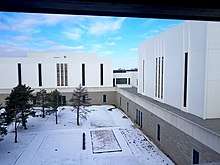
- Henry Flagler's mausoleum in St. Augustine, Florida
- Grant's Tomb in New York, New York
- Abraham Lincoln's tomb in Springfield, Illinois
- Miles Mausoleum in Arlington National Cemetery
- Queen of Heaven Mausoleum in Queen of Heaven Cemetery, Hillside, Illinois
- Rose Chapel Mausoleum in Roseland Park Cemetery, Berkley, Michigan
- Shrine of the Good Shepherd Chapel Mausoleum in Green Bay, Wisconsin
- Tacoma Mausoleum in Tacoma, Washington
- Tombs of the Uga mascots inside Sanford Stadium in Athens, Georgia
- Brigadier General Egbert Ludovicus Viele's Egyptian-style pyramid mausoleum in West Point, New York
- Rapper XXXTentacion's mausoleum at The Gardens of Boca Raton in Boca Raton, Florida
Oceania
- Massey Memorial in Wellington, New Zealand where New Zealand Prime Minister William Massey and his wife are interred.
- Savage Memorial at Bastion Point in Auckland, New Zealand where New Zealand Prime Minister Michael Joseph Savage is interred.
- Royal Mausoleum in Honolulu, Hawaii where the members of the Kamehameha and Kalākaua dynasties are interred.
See also
- List of types of funerary monument
- Morgue or mortuary
- National Cemetery
- Ohel (grave)
- Sepulchre
Notes
- ^ The plurals mausoleums and mausolea are both used in English, although mausoleums is more common.
Footnotes
- Toms, J. Mason (Winter 2019). "Arkansas Listings in the National Register of Historic Places: The Community Mausoleums of Cecil E. Bryan". Arkansas Historical Quarterly. 78 (4): 423–431. ISSN 0004-1823.
- Paul Veyne, in A History of Private Life: I. From Pagan Rome to Byzantium, Veyne, ed. (Harvard University Press) 1987:416.
- al-Qummi, Ja'far ibn Qūlawayh (2008). Kāmil al-Ziyārāt. trans. Sayyid Mohsen al-Husaini al-Mīlāni. Shiabooks.ca Press. p. 63.
External links
| Look up mausoleum in Wiktionary, the free dictionary. |
| Wikimedia Commons has media related to Mausoleums. |
- Mausolea and Monuments Trust, gazetteer of mausolea in England
- Marvelous Mausoleums Around The World - slideshow at The Huffington Post
